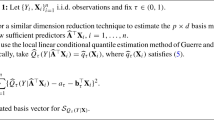Abstract
In a regression context where a response variable Y ∈ ℝ is recorded with a covariate X ∈ ℝ p, two situations can occur simultaneously: (a) we are interested in the tail of the conditional distribution and not on the central part of the distribution and (b) the number p of regressors is large. To our knowledge, these two situations have only been considered separately in the literature. The aim of this paper is to propose a new dimension reduction approach adapted to the tail of the distribution in order to propose an efficient conditional extreme quantile estimator when the dimension p is large. The results are illustrated on simulated data and on a real dataset.
Similar content being viewed by others
References
Araújo Santos, P., Fraga Alves, M.I., Gomes, M.I.: Peaks over random threshold methodology for tail index and high quantile estimation. REVSTAT 4(3), 227–247 (2006)
Basu, D., Pereira, C.A.B.: Conditional independence in statistics. Sankhyā 45(3), Series A, 324–337 (1983)
Chaudhuri, P.: Nonparametric estimates of regression quantiles and their local Bahadur representation. Ann. Stat. 19(2), 760–777 (1991)
Cook, R.D.: On the interpretation of regression plots. J. Am. Stat. Assoc. 89(425), 177–189 (1994)
Cook, R.D., Forzani, L.: Likelihood-based sufficient dimension reduction. J. Am. Stat. Assoc. 104, 197–208 (2009)
Cook, R.D., Weisberg, S.: Discussion of sliced inverse regression for dimension reduction. J. Am. Stat. Assoc. 86, 328–332 (1991)
Daouia, A., Gardes, L., Girard, S.: On Kernel smoothing for extremal quantile regression. Bernoulli 19(5B), 2557–2589 (2013)
Daouia, A., Gardes, L., Girard, S., Lekina, A.: Kernel estimators of extreme level curves. Test 20(2), 311–333 (2011)
Davison, A.C., Smith, R.L.: Models for exceedances over high thresholds. J. R. Stat. Soc. Ser. B 52, 393–442 (1990)
Davison, A.C., Ramesh, N.I.: Local likelihood smoothing of sample extremes. J. R. Stat. Soc. Ser. B 62, 191–208 (2000)
de Haan, L., Ferreira, A.: Extreme Value Theory: An Introduction. Springer (2006)
Eastoe, E.F., Tawn, J.A.: Modelling non-stationary extremes with application to surface level ozone. J. R. Stat. Soc. Ser. C 58, 25–45 (2009)
Fisher, R.A., Tippett, L.H.C.: Limiting forms of the frequency distribution of the largest or smallest member of a sample. Proc. Camb. Philos. Soc. 24, 180–190 (1928)
Fraga Alves, M.I., Gomes, M.I., de Haan, L., Neves, C.: A note on second order conditions in extreme value theory: linking general and heavy tail conditions. REVSTAT - Stat. J. 5(3), 285–304 (2007)
Gannoun, A., Girard, S., Guinot, C., Saracco, J.: Sliced inverse regression in reference curves estimation. Comput. Stat. Data Anal. 46(1), 103–122 (2004)
Gardes, L.: A general estimator for the extreme value index: applications to conditional and heteroscedastic extremes. Extremes 18(3), 479–510 (2015)
Gardes, L., Girard, S.: Conditional extremes from heavy-tailed distributions: an application to the estimation of extreme rainfall return levels. Extremes 13(2), 177–204 (2010)
Gardes, L., Girard, S.: Functional kernel estimators of large conditional quantiles. Electron. J. Stat. 6, 1715–1744 (2012)
Gardes, L., Girard, S.: On the estimation of the functional Weibull tail-coefficient. J. Multivar. Anal. 146, 29–45 (2016)
Gasser, T., Müller, H.G.: Estimating regression functions and their derivatives by the kernel method. Scand. J. Stat. 11, 171–185 (1984)
Gnedenko, B.V.: Sur la distribution limite du terme maximum d’une série aléatoire. Ann. Math. 44, 423–453 (1943)
Hooke, R., Jeeves, T.A.: Direct search solution of numerical and statistical problems. J. ACM 8(2), 212–229 (1961)
Han, S., Bian, H., Feng, Y., Liu, A., Li, Zeng, F., Zhang, X: Analysis of the relationship between O3,, NO and NO2 in Tianjin, China. Aerosol Air Qual. Res. 11, 128–139 (2011)
Ichimura, H.: Semiparametric least squares (SLS) and weighted SLS estimation of single-index models. J. Econ. 58, 71–120 (1993)
Koenker, R., Basset, G.S.: Regression quantiles. Econometrica 46, 33–50 (1978)
Li, K.C.: Sliced inverse regression for dimension reduction. J. Am. Stat. Assoc. 86, 316–327 (1991)
Li, K.C.: On principal hessian directions for data visualization and dimension reduction: another application of Stein’s lemma. J. Am. Stat. Assoc. 87, 1025–1039 (1992)
Nadaraya, E.A.: On estimating regression. Theory Probab. Appl. 9(1), 141–142 (1964)
Northrop, P.J., Jonathan, P.: Threshold modelling of spatially dependent non-stationary extremes with application to hurricane-induced wave heights. Environmetrics 22(7), 799–809 (2011)
Parzen, E.: On the estimation of a probability density function and mode. Ann. Math. Stat. 33, 1065–1076 (1962)
Russell, B.T., Cooley, D., Porter, W.C., Reich, B.J., Heald, C.L.: Data mining for extreme behavior with application to ground level ozone. Ann. Appl. Stat. 10, 1673–1698 (2016)
Scrucca, L.: Model-based SIR for dimension reduction. Comput. Stat. Data Anal. 55, 3010–3026 (2011)
Wang, E., Tsai, C.: Tail index regression. J. Am. Stat. Assoc. 104(487), 1233–1240 (2009)
Watson, G.S.: Smooth regression analysis. Sankhyā 26(15), 175–184 (1964)
Weisberg, W.: Dimension reduction regression in R. J. Stat. Softw. 7, 1–22 (2002)
Wu, T.Z., Yu, K., Yu, Y.: Single-index quantile regression. J. Multivar. Anal. 101, 1607–1621 (2010)
Xia, Y.: Model checking in regression via dimension reduction. Biometrika 96(1), 133–148 (2009)
Yu, K., Jones, M.C.: Local linear quantile regression. J. Am. Stat. Assoc. 93(441), 228–237 (1998)
Author information
Authors and Affiliations
Corresponding author
Rights and permissions
About this article
Cite this article
Gardes, L. Tail dimension reduction for extreme quantile estimation. Extremes 21, 57–95 (2018). https://doi.org/10.1007/s10687-017-0300-x
Received:
Revised:
Accepted:
Published:
Issue Date:
DOI: https://doi.org/10.1007/s10687-017-0300-x



